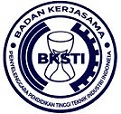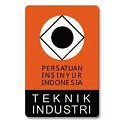Analysis of Occupational Health and Safety (OHS) on the Cable Tray Support Farming MSP Fabrication Project Using the Hazard Identifications and Risk Assessment (HIRA) and Hazard and Operability (HAZOP) Methods
Abstract
A cable tray project is one of the joint ventures that PT. Swadaya Graha and PT. Triraya have finished. Workplace mishaps are unavoidable when working on a project. There were multiple work accidents on the cable tray construction project from February 2023 to May 2023, according to the work accident report of PT. Swadaya Graha. One of these workplace mishaps leaves a victim with minor wounds and burns. In order to encourage employees to stay vigilant and exercise caution whenever working on a project, this research was done to reduce the likelihood of workplace accidents and to learn about the possible risks associated with working on a cable tray project. Using the methods of Hazard Identification and Risk Assessment (HIRA) and Hazard and Operability (HAZOP), this study located potential danger sources in the cable tray project work. This investigation produced 35 potential hazard findings, including 5 dominant potential hazards (hazards with the highest level value) and several recommendations for corrective measures that could benefit the company, such as adhering to the SOP that has been established.
Keywords: Work Accidents, Potential Hazards, Cable Tray, HAZOP, HIRA
Full Text:
PDFReferences
A. Haslindah, A. Andrie, F. Nur Hidayat, and S. Aryani, “Penerapan Metode HAZOP Untuk Keselamatan Dan Kesehatan Kerja Pada Bagian Produksi Air Minum Dalam Kemasan Cup Pada PT. Tirta Sukses Perkasa (CLUB),” J. Ind. Eng. Manag., vol. 1, no. 01, pp. 20–24, 2020, doi: 10.47398/justme.v1i01.5.
I. Rahmanto and M. Ihsan Hamdy, “Analisa Resiko Kecelakaan Kerja Karyawan Menggunakan Metode Hazard and Operability (HAZOP) di PT PJB Services PLTU Tembilahan,” J. Teknol. dan Manaj. Ind. Terap., vol. 1, no. 2, pp. 53–60, 2022, doi: 10.55826/tmit.v1i2.15.
B. Suhardi, P. W. Laksono, V. E. A. Ayu, J. Mohd.Rohani, and T. S. Ching, "Analysis of the potential Hazard Identification and Risk Assessment (HIRA) and Hazard Operability Study (HAZOP): Case study," Int. J. Eng. Technol., vol. 7, no. 3, pp. 1–7, 2018, doi: 10.14419/ijet.v7i3.24.17290.
N. Susanto, F. Azzahra, and A. H. Putra, "Application of Hazard and Operability Study Methods (HAZOP) to asses and control hazard risk in spinning department using at textile industrial," IOP Conf. Ser. Earth Environ. Sci., vol. 1098, no. 1, 2022, doi: 10.1088/1755-1315/1098/1/012006.
R. Rusli, I. Zulkarnain, and Y. Ekandari, "Risk Analysis of Occupational Safety and Health (OSH) Using the Hazard And Operability Study (HAZOP) Method for the Semani Drainage Project (Sentosa-Remaja-A. Yani)," JSE J. Sci. Eng., vol. 1, no. 2, pp. 66–72, 2024, doi: 10.30650/jse.v1i2.3883.
M. A. Wagiman and F. Yuamita, “Analisis Tingkat Risiko Bahaya Kerja Menggunakan Metode Hazop (Hazard And Operability) Pada PT Madubaru PG/PS Madukismo.,” J. Teknol. dan Manaj. Ind. Terap., vol. 1, no. 4, pp. 277–285, 2022, doi: 10.55826/tmit.v1iiv.34.
B. A. Saputro and D. Suastiyanti, “Analisis Resiko Kesehatan dan Keselamatan Kerja (K3) Dengan Menggunakan Metode HAZOP Pada Proses Produksi Aluminium di PT XYZ,” Innov. J. Soc. Sci. Res., vol. 3, no. 6, pp. 7915–7923, 2023.
E. Rudyarti, "Study of the Effectiveness of Implementing Occupational Safety and Health with the Hazop Method in the Cikarang Industrial Center," Indones. J. Sport Manag. Phys. Educ., vol. 1, no. 1, pp. 59–70, 2022, doi: 10.55927/ijsmpe.v1i1.2284.
Fenita Purnama Sari Indah, Junaida Rahmi, Ribka Milenia Elsaday Manurung, Tri Okta Ratnaningtyas, and Syaiful Bahri, “Analysis Of Occupational Safety And Health Risk Using The Hazard And Operational Study (Hazops) Method For Repairman,” Texas J. Med. Sci., vol. 27, pp. 143–147, 2023, doi: 10.62480/tjms.2023.vol27.pp143-147.
S. O. D. Ningsih and S. W. Hati, “Analisis Resiko Keselamatan Dan Kesehatan Kerja (K3) Dengan Menggunakan Metode Hazard and Operability Study (Hazop) Pada Bagian Hydrotest Manual Di Pt. Cladtek Bi Metal Manufacturing," J. Appl. Bus. Adm., vol. 3, no. 1, pp. 29–39, 2019, doi: 10.30871/jaba.v3i1.1288.
H. C. Suroso and K. E. Yanuar, “Analisa Potensi Bahaya pada Perusahaan Fabrikasi Baja menggunakan Metode HAZOP (Hazard and Operability Study),” J. Adv. Inf. Ind. Technol., vol. 2, no. 1, pp. 13–21, 2020, doi: 10.52435/jaiit.v2i1.16.
R. Ariyani, R. Suarantalla, and I. Mashabai, “Analisa Potensi Kecelakaan Kerja Pada Pt. Pln (Persero) Sumbawa Menggunakan Metode Hazard and Operability Study (Hazop),” J. Ind. Teknol. Samawa, vol. 2, no. 1, pp. 11–21, 2021, doi: 10.36761/jitsa.v2i1.1019.
C. Anwar, W. Tambunan, and S. Gunawan, “Analisis Kesehatan Dan Keselamatan Kerja (K3) Dengan Metode Hazard and Operability Study (Hazop),” J. Mech. Eng. Mechatronics, vol. 4, no. 2, p. 61, 2019, doi: 10.33021/jmem.v4i2.825.
M. Nur, “Analisis Keselamatan dan Kesehatan Kerja Menggunakan Metode Hazard And Operability Study (HAZOP) Di PT. XYZ," J. Tek. Ind. J. Has. Penelit. dan Karya Ilm. dalam Bid. Tek. Ind., vol. 4, no. 2, p. 133, 2020, doi: 10.24014/jti.v4i2.6627.
A. Haslindah, I. Idrus, Y. Pongsimpin, and R. Budicalista, “Lingkungan Kerjamenggunakan Metode Hazard and Operability ( Hazop ).,” Progr. Stud. Tek. Ind. Fak. Tek. Univ. Islam Makassar, vol. 14, pp. 33–36, 2019.
R. Darmawan, N. Ummi, and A. Umyati, "Metode Hazard Identification And Risk Assessment ( Hira ) Di Area Batching Plant Pt Xyz.," J. Tek. Ind., vol. 5, no. 3, pp. 308–313, 2017.
M. E. Albar, L. Parinduri, and S. R. Sibuea, “Analisis Potensi Kecelakaan Menggunakan Metode Hazard Identification and Risk Assessment (HIRA),” Bul. UtamaTeknik, vol. 17, no. 3, pp. 241–245, 2022.
M. B. Anthony, “Identifikasi dan Analisis Risiko Keselamatan dan Kesehatan Kerja (K3) pada Proses Instalasi Hydraulic System Menggunakan Metode HIRA (Hazard Identification and Risk Assesment) di PT. HPP," J. Media Tek. dan Sist. Ind., vol. 4, no. 2, p. 60, 2020, doi: 10.35194/jmtsi.v4i2.1030.
S. Larasati, S. Suroto, and B. Widjasena, “Analisis Potensi Bahaya Dengan Menggunakan Metode Hira (Hazard Identification and Risk Assessment) Pada Pabrik Roti Tawar X Boyolali,” J. Kesehat. Masy., vol. 9, no. 6, pp. 760–764, 2021, doi: 10.14710/jkm.v9i6.31383.
M. B. Anthony, "Analisis Risiko Kerja pada Area Hot Metal Treatment Plant Divisi Blast Furnace dengan Metode Hazard Identification and Risk Assessment (HIRA)," J. INTECH Tek. Ind. Univ. Serang Raya, vol. 5, no. 1, p. 35, 2019, doi: 10.30656/intech.v5i1.1461.
I. Adiasa, “Analisis Potensi Bahaya Pada Pt. Infrastruktur Terbarukan Buana Mengunakan Metode Hazard Identification and Risk Assessment (Hira) Lombok Timur,” J. Ind. Teknol. Samawa, vol. 3, no. 1, pp. 54–61, 2022, doi: 10.36761/jitsa.v3i1.1566.
F. Moniaga and V. S. Rompis, “Analisa Sistem Manajemen Kesehatan Dan Keselamatan Kerja (Smk3) Proyek Konstruksi Menggunakan Metode Hazard Identification and Risk Assessment,” J. Ilm. Realt., vol. 15, no. 2, pp. 65–73, 2019, doi: 10.52159/realtech.v15i2.86.
R. S. Ramadhan and N. L. P. Hariastuti, “Upaya Meminimalisasi Kecelakaan Kerja Pada Bagian Warehouse Pt. Gading Murni Dengan Menggunakan Metode Hazard Identification and Risk Assesment (Hira) Dan Hazard and Operability Study (Hazop),” Pros. SENASTITAN Semin. Nas. Teknol. Ind. Berkelanjutan, vol. 2, no. 0, pp. 443–448, 2022, [Online]. Available: http://ejurnal.itats.ac.id/senastitan/article/view/2767
S. Khairiah, “Hubungan Antara Faktor Unsafe Action Dengan Kecelakaan Kerja Pada Pekerja Proyek Konstruksi Dengan Metode Hira (Hazard Identification and Risk Assessment) DI PT X Surabaya,” Med. Technol. Public Heal. J., vol. 4, no. 2, pp. 238–249, 2020, doi: 10.33086/mtphj.v4i2.797.
D. A. F. Ferlania and Y. R. Rahadian, “Analisa Potensi Bahaya Dengan Metode HIRA ( Hazard Identification And Risk Asessment ) Di Departemen Produksi PT. ABC," IMEJ (Industrial Manag. Eng. Juornal), vol. 2, no. 2, pp. 84–94, 2023.
A. Y. Ambarani and A. R. Tualeka, “Hazard Identification and Risk Assessment (Hira) Pada Proses Fabrikasi Plate Tanki 42-T-501a Pt Pertamina (Persero) Ru Vi Balongan,” Indones. J. Occup. Saf. Heal., vol. 5, no. 2, p. 192, 2017, doi: 10.20473/ijosh.v5i2.2016.192-203.
DOI: http://dx.doi.org/10.24014/jti.v10i1.29692
Refbacks
- There are currently no refbacks.
Copyright (c) 2024 Cindy Aulia Salsabila

This work is licensed under a Creative Commons Attribution-NonCommercial-ShareAlike 4.0 International License.
Jurnal Teknik Industri
P-ISSN 2460-898X | E-ISSN 2714-6235
Published by:
Industrial Engineering Department
Universitas Islam Negeri Sultan Syarif Kasim Riau, Indonesia
Office Address:
H.R. Soebrantas KM 15.5, Tampan, Pekanbaru, Riau, Indonesia 28293
email: jti.fst@uin-suska.ac.id
Indexed by:
JTI : Jurnal Teknik Industri under a Creative Commons Attribution-NonCommercial-ShareAlike 4.0 International License.

















